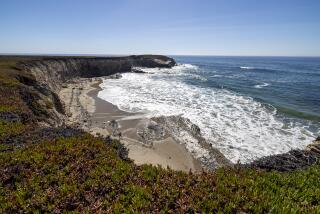Tentative oil plan for Alaska’s National Petroleum Reserve
- Share via
SEATTLE -- The U.S. Interior Department opened the door to the possibility of an oil pipeline across the National Petroleum Reserve in Alaska and to oil and gas leasing on 11.8 million acres of it.
The draft development proposal unveiled Monday by U.S. Interior Secretary Ken Salazar represents the federal government’s first coordinated plan for the 22-million-acre reserve, which has seen limited oil production in recent years despite controversy over potential threats to wildlife.
The reserve, which lies west of the oil fields on Alaska’s North Slope, is home to the famous Western Arctic caribou herd, numbering about 325,000, and a smaller herd of 45,000 caribou that migrates near Teshekpuk Lake.
The largest single block of public land in the country, the reserve contains an estimated 549 million barrels of economically recoverable oil and 8.7 trillion cubic feet of natural gas.
The compromise plan -- unveiled after a long study that collected more than 400,000 public comments -- would continue to protect some of the most ecologically sensitive areas, including Teshekpuk Lake, home to tens of thousands of geese and brant that migrate to the far north during sunny Arctic summers.
Hundreds of thousands of birds visit the petroleum reserve each summer for nesting and molting.
The plan also identifies crucial wildlife habitat along the Colville River, home to many nesting raptors, in the Utukok River Uplands, Pearl Bay and Kasegaluk Lagoon near Wainwright. Many of those areas would be off-limits to oil and gas production under the proposed plan.
Monday’s release of the draft proposal begins a 30-day review period, after which Salazar could issue a final decision.
“There are those who would argue that what we ought to do with this very special area is simply close it off for all development and simply put it into permanent conservation forever. In my view, that would be the wrong way to go, because it’s important for us to recognize that we also have energy needs in the United States,” Salazar told reporters at a press conference in Anchorage. “What we want to do is we want to make sure we don’t mess it up.”
Authorizing the study of a pipeline opens the door to one of the most important issues related to development in the nearby Chukchi Sea. Shell Alaska is poised to begin exploratory drilling there later this month — if final permits are approved — but any major oil produced there would either have to be hauled away in tankers or, more likely, pumped through a major new pipeline that would connect to the existing Trans-Alaska pipeline at Prudhoe Bay.
Salazar said the tentative plan “allows a pathway forward” for construction of a pipeline across the reserve. A full environmental analysis would have to be done before any such facility could be approved, he said.
Conservation organizations generally applauded the proposed plan, saying the decision to set aside areas of special ecological significance was important, as was the apparent signal that no pipeline would run near Teshekpuk Lake.
“The administration is moving to find the right balance on lands within the NPR-A. Offshore in the Arctic, where there are no permanently protected areas, this balance is still lacking,” Jamie Williams, president of the Wilderness Society, said in a statement.
Alaska’s congressional delegation, which has pushed for more extensive oil and gas development in the reserve, said federal officials chose the most restrictive option.
U.S. Sen. Mark Begich (D-Alaska) also said the protection of wildlife areas at Kasegaluk Lagoon near Wainwright, on the northwest coast, appears to put off-limits one of the most logical areas for bringing a pipeline ashore.
“We’ve known since the beginning that a pipeline across the NPR-A is a critical piece of the puzzle for successful Arctic development,” Begich said in a statement. “I was pleased by Secretary Salazar’s statement that the United States cannot be left behind in the Arctic. However, today’s decision creates many more questions than answers about how we are going to get billions of barrels of oil from the Chukchi Sea into [the Trans-Alaska pipeline].”
ALSO:
Boater’s strange odyssey exposes gap in JFK airport security
Billy Graham, 93, hospitalized and responding well to treatment
Wedding day stabbing: Pennsylvania woman accused of killing fiance
More to Read
Sign up for Essential California
The most important California stories and recommendations in your inbox every morning.
You may occasionally receive promotional content from the Los Angeles Times.













